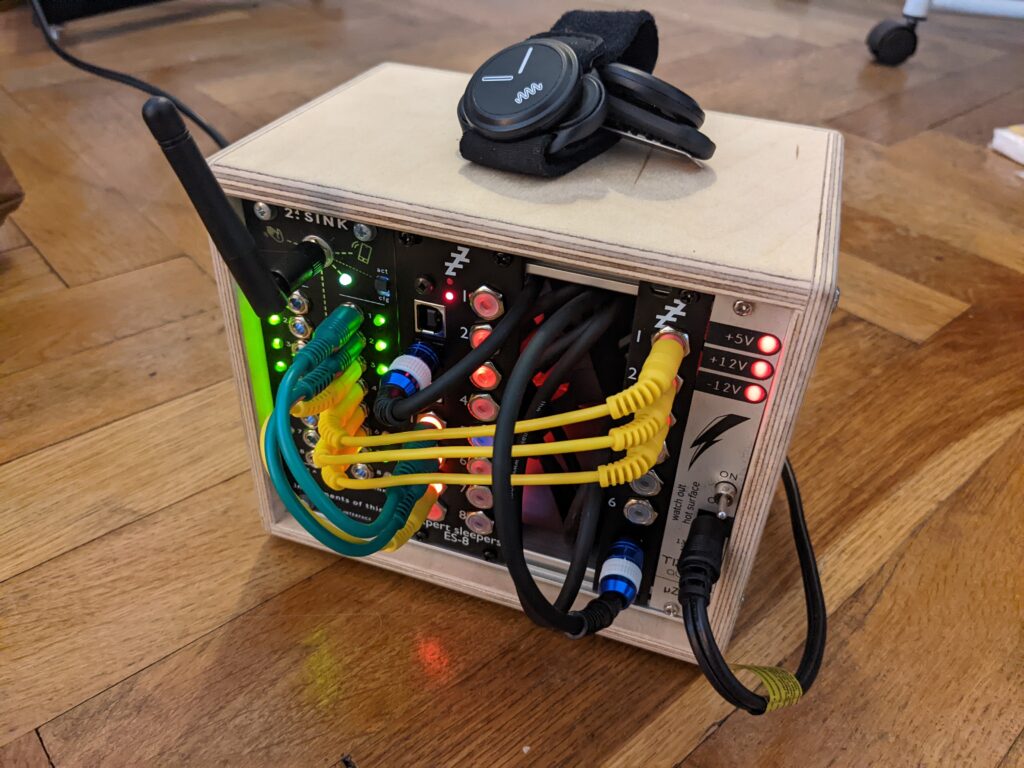Leaving speakers aside, the hardware requirements mainly consist of wireless wristbands with accelerometers and gyro sensors, a computer that can run Pure Data and Ableton and everything that it takes to get the wristbands and the computer to communicate.
As I had planned last semester, I got to try out the 2.4SINK Kit by Instruments of Things, which is a set of wireless wristband sensors and a receiver. The receiver is made for modular Eurorack setups, meaning that wristband movements will be translated into control voltages (CV’s) that can in turn be used to modulate synthesizers or effect panels. This is of course not necessarily optimal for my application, where I need all the wristband data in my laptop anyway. Thankfully, I was not the first one at my university that wanted to use the 2.4SINK Kit in that way: The module was already built into a small Doepfer box, together with an Expert Sleepers USB Audio Interface, that allowed me to receive up to 10 CV inputs (including the input expansion module) via USB on my laptop.
Wristband sensors
The sensors look very sturdy and of good quality, but also thin and subtle. On the backside, each watch has two metal pins that are used to switch the sensor on (if both pins are touched at the same time), as well as they are used as a mounting contraption to fit them on belt clips or fabric wristbands (“click-mount”). As soon as a sensor is switched on, it will go into calibration mode, which means that it is of utter importance to have the sensor lying still on a flat surface during this process (otherwise the values will drift off constantly).
Receiver
The receiver consists of an antenna, a little toggle button that switches between “configuration” and “active” mode and 16 dynamically configurable outputs. When switched on, the 2.4SINK receiver will create a wireless LAN network, which, if accessed, will provide the opportunity to visit the configuration page of the 2.4SINK Kit. On the configuration page, it is possible to change a few global settings, as well as individual settings for all 16 outputs (while the switch on the receiver is set to “configuration mode”). For each output, it is possible to choose which parameter of which sensor (up to seven sensors can be connected) should modulate the output. For each sensor, six parameters can be chosen:
- Rotation X
- Rotation Y
- Rotation Z
- Acceleration X
- Acceleration Y
- Acceleration Z
Furthermore, it is possible to output LFO signals that are modulated by the sensor’s parameters. However, this is much more interesting for a modular setup and not very suitable for my use case.

USB Interface
The Expert Sleepers USB Interface (ES8 plus ES6 input expansion module) works just as most other USB audio interfaces do. The CVs are normalized as input signals ranging from -1 or 0 (depending on the type of input: unipolar/bipolar) to 1.
While there were only two sensors available, the 2.4SINK receiver would have still supported to read out all parameters from both sensors (six plus six parameters, while the receiver features 16 outputs), but the true bottleneck in this case was the Expert Sleepers audio interface, which only has 10 inputs, meaning that not even all parameters from both sensors could be read simultaneously. This led me to the decision that the outcome for this semester would only be a proof-of-concept demonstration with only one sensor.